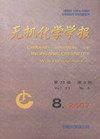过渡金属氧化物对聚磷酸铵热分解的影响机理
IF 0.7
4区 化学
Q4 CHEMISTRY, INORGANIC & NUCLEAR
引用次数: 4
摘要
过渡金属氧化物(MO)可以明显影响聚磷酸铵(APP)的热分解过程,从而提高聚合物中基于APP的膨胀型阻燃复合材料的阻燃效率。在APP中加入等量的ZnO、Fe2O3和TiO2,研究MO对APP热分解行为的影响,并分别通过热重分析(TGA)、x射线光电子能谱(XPS)和x射线粉末衍射(XRD)分析在相互作用过程中金属原子和磷原子的化学状态和晶体结构的演变。TGA和XPS光谱结果表明,MO在前期可以催化APP中NH3和H2O的释放,后期由于金属磷酸盐的形成导致高温残留物增加。NH3和H2O释放过程的催化活性顺序为:ZnO>Fe2O3>TiO2, APP热分解产物P-O的交联能力顺序为:Fe2O3>ZnO>TiO2。XRD结果表明,APP可与ZnO、Fe2O3和TiO2在高温下分别反应生成Zn(PO3)(2)、Fe-4(P2O7)(3)和TiP2O7。本文章由计算机程序翻译,如有差异,请以英文原文为准。
Influencing Mechanism of Transition Metal Oxide on Thermal Decomposition of Ammonium Polyphosphate
Transition metal oxide (MO) can obviously influence the thermal decomposition process of ammonium polyphosphate (APP) to improve the flame retardant efficiency of intumescent flame retardant composites based on APP in polymer. ZnO, Fe2O3 and TiO2, in same amount were added into APP to study the influence of MO on thermal decomposition behavior of APP, and to analyze the evolution of chemical state of metallic atoms and phosphorus atom and crystal structure in the interaction processes by thermogravimetric analysis (TGA), X-ray photoelectron spectroscopy (XPS) and X-ray powder diffraction (XRD) respectively. TGA and XPS spectra showed that MO could catalyze the releasing of NH3 and H2O of APP in the earlier period, and increase the high temperature residue in the later period due to the formation of metallic phosphate. The sequence of catalytic activity for the process of releasing of NH3 and H2O was as follows: ZnO>Fe2O3>TiO2, and that of cross-linking ability for thermal decomposition product P-O of APP was as follows: Fe2O3>ZnO>TiO2. XRD showed that APP could react with ZnO, Fe2O3 and TiO2 to produce Zn(PO3)(2), Fe-4(P2O7)(3) and TiP2O7, respectively, at high temperature.
求助全文
通过发布文献求助,成功后即可免费获取论文全文。
去求助
来源期刊

无机化学学报
化学-无机化学与核化学
CiteScore
1.40
自引率
42.90%
发文量
8709
审稿时长
2.2 months
期刊介绍:
“Chinese Journal of Inorganic Chemistry” publishes fundamental studies in all phases of inorganic chemistry, including solid-state chemistry, coordination chemistry, inorganic materials chemistry, bioinorganic chemistry, organometallic chemistry, theoretical inorganic chemistry, supermolecule chemistry, applied inorganic chemistry and related field of catalysis. Emphasis is on the synthesis, thermodynamics, kinetics, spectroscopy, structure and bonding properties of new and known compounds.
In addition to full-length research articles, “Chinese Journal of Inorganic Chemistry” also publishes notes, letters, and reviews. “Chinese Journal of Inorganic Chemistry” accepts manuscript written in simplified Chinese or English.
 求助内容:
求助内容: 应助结果提醒方式:
应助结果提醒方式:


